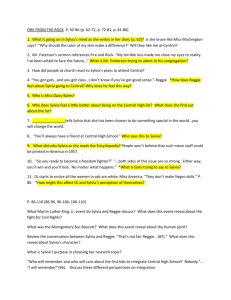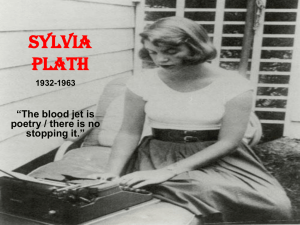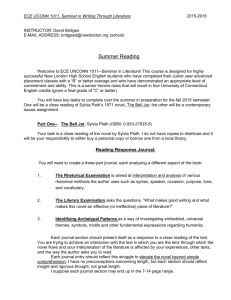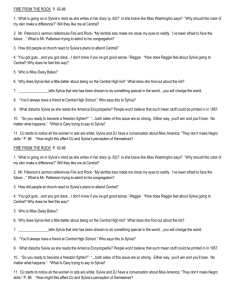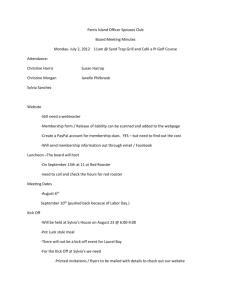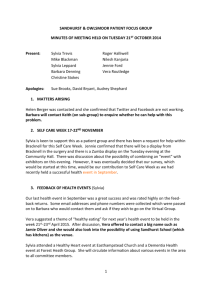STORY STUDY SHEET TITLE: “The Lesson” AUTHOR: Toni Cade
advertisement
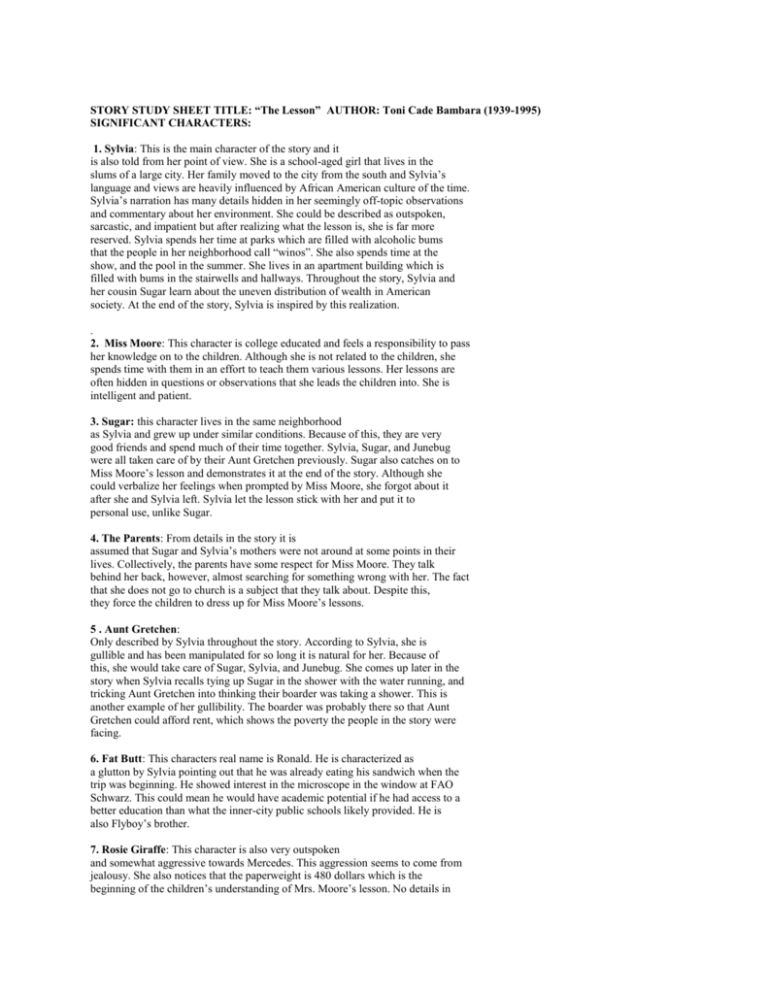
STORY STUDY SHEET TITLE: “The Lesson” AUTHOR: Toni Cade Bambara (1939-1995) SIGNIFICANT CHARACTERS: 1. Sylvia: This is the main character of the story and it is also told from her point of view. She is a school-aged girl that lives in the slums of a large city. Her family moved to the city from the south and Sylvia’s language and views are heavily influenced by African American culture of the time. Sylvia’s narration has many details hidden in her seemingly off-topic observations and commentary about her environment. She could be described as outspoken, sarcastic, and impatient but after realizing what the lesson is, she is far more reserved. Sylvia spends her time at parks which are filled with alcoholic bums that the people in her neighborhood call “winos”. She also spends time at the show, and the pool in the summer. She lives in an apartment building which is filled with bums in the stairwells and hallways. Throughout the story, Sylvia and her cousin Sugar learn about the uneven distribution of wealth in American society. At the end of the story, Sylvia is inspired by this realization. . 2. Miss Moore: This character is college educated and feels a responsibility to pass her knowledge on to the children. Although she is not related to the children, she spends time with them in an effort to teach them various lessons. Her lessons are often hidden in questions or observations that she leads the children into. She is intelligent and patient. 3. Sugar: this character lives in the same neighborhood as Sylvia and grew up under similar conditions. Because of this, they are very good friends and spend much of their time together. Sylvia, Sugar, and Junebug were all taken care of by their Aunt Gretchen previously. Sugar also catches on to Miss Moore’s lesson and demonstrates it at the end of the story. Although she could verbalize her feelings when prompted by Miss Moore, she forgot about it after she and Sylvia left. Sylvia let the lesson stick with her and put it to personal use, unlike Sugar. 4. The Parents: From details in the story it is assumed that Sugar and Sylvia’s mothers were not around at some points in their lives. Collectively, the parents have some respect for Miss Moore. They talk behind her back, however, almost searching for something wrong with her. The fact that she does not go to church is a subject that they talk about. Despite this, they force the children to dress up for Miss Moore’s lessons. 5 . Aunt Gretchen: Only described by Sylvia throughout the story. According to Sylvia, she is gullible and has been manipulated for so long it is natural for her. Because of this, she would take care of Sugar, Sylvia, and Junebug. She comes up later in the story when Sylvia recalls tying up Sugar in the shower with the water running, and tricking Aunt Gretchen into thinking their boarder was taking a shower. This is another example of her gullibility. The boarder was probably there so that Aunt Gretchen could afford rent, which shows the poverty the people in the story were facing. 6. Fat Butt: This characters real name is Ronald. He is characterized as a glutton by Sylvia pointing out that he was already eating his sandwich when the trip was beginning. He showed interest in the microscope in the window at FAO Schwarz. This could mean he would have academic potential if he had access to a better education than what the inner-city public schools likely provided. He is also Flyboy’s brother. 7. Rosie Giraffe: This character is also very outspoken and somewhat aggressive towards Mercedes. This aggression seems to come from jealousy. She also notices that the paperweight is 480 dollars which is the beginning of the children’s understanding of Mrs. Moore’s lesson. No details in the story indicate that she had as full an understanding is Sylvia or Sugar however. 8: Mercedes: This character is tidy and tries to be more proper than the other children. She has a Godmother that gave her a desk and stationary. She doesn’t seem to understand the lesson at all. When they are all looking at the boat at first she seems to value it based on the fact that it is expensive. She is the subject of jokes by the other children. 9. Junebug: This character is childish and probably younger that Sugar and Sylvia. The only evidence of gender is that when Junebug is in the taxi with Sugar, Sylvia, and Flyboy, Sylvia only calls Flyboy a “faggot” when they start putting on lipstick. She also stayed with Aunt Gretchen sometimes. 10. QT: He is also younger than the other children. He stared longingly at the sailboat, and acknowledged that the toy was very expensive, which is more the Mercedes did. In this way, QT is used to characterize other characters in the story. 11. Flyboy: This character is an outspoken and clever. It is mentioned in the story that he manipulates white people in school to sympathize with him. At the end of the story when Flyboy says that he would like a shower and that it was a tiring day it is revealed that he also had some understanding of the lesson. This adult-like remark could signify that the kids are exposed to life at a very young age and that they mature very early. SETTING AND IT’S SIGNIFICANCE: The story is set in a slum or ghetto in a city. This affects the characters heavily in many aspects. Their culture is very interwoven with city living and their language, education, family values, traditions and social views are affected by their environment. As Miss Moore says, “Where we are is who we are”. The characters in the story live in apartment complexes near family because when they first came North they all lived together in the same apartment. This is an example of the poverty they live in. The places that the children socialize are littered with alcoholic bums that urinate all over. The action in the story begins at the mailbox with all of the children and Miss Moore. The mailbox is symbolic because it is where mail and information is received, and the lesson is started and ended at the mailbox. The next setting is the taxis that the group rides in. This is significant because a taxi is a luxury that the children’s families could never afford. This is shown by the children's amazement at the meter in the taxi. Miss Moore gives Sylvia a five dollar bill to give her a chance to have financial responsibilities. Sylvia is not quite ready for this challenge when she decides not to tip the driver. This shows a childish selfishness in her character. Although Sylvia and Sugar think they have gotten away with keeping the rest of the money, Miss Moore was probably testing Sylvia to see if she could be responsible and return the money that was not hers. When she fails to do so, Miss Moore likely does not say anything because it was gift that Sylvia was to proud to accept. This is an example of Miss Moore’s hidden motives behind everything she does with the children. After they get out of the Taxi they realize that they are on 5th avenue with people in fancy clothes. Sylvia points out when she sees a lady in a fur coat in the middle of the summer that she thinkswhite people are crazy. This is an example of how her neighborhood dictates her feelings about large groups of people. This underlying feeling about a large majority of people in America at the time would put these children at a great disadvantage because it distances them from so many authority figures and people. The next setting of the story is FAO Schwarz, a store that the children’s families would not be likely to shop at or even browse in. Miss Moore suggests that they look in the windows first because she wants them to notice the prices before they go in. This is because she wanted to demonstrate that the store is not a place they could buy anything or would not have any business in. The significance of going to a toy store is that a toy store is a place that the kids would likely see things that interest them. Miss Moore knows this and waits for them to start noticing the prices on the toys. This is another example of Miss Moore’s intelligence. She patiently waits for them to see the prices and after they have digested this she suggests they go in but waits and lets them lead the way. When Sugar and Sylvia get to the door the stop and start to feel shame. This is because Sylvia and Sugar are beginning to understand the lesson that Miss Moore is teaching them. Mercedes, who has not noticed this, gets through and goes in. Sylvia then parallels the shame she felt in the Catholic church. Connecting the two experiences shows that Sylvia is starting to understand. She doesn’t fullyunderstand the feelings yet because when Sugar touches the boat, she wants to hit someone. Violence is a reaction to the unknown that is very basic and shows Sylvia still has more to learn. After FAO Schwarz, they ride back home on the subway because Miss Moore wants them to compare the taxi and the subway after they have seen what they don’t have. They then return to the mailbox and Sugar verbalizes what Sylvia had previously had been unable to understand. After they walk away and Sylvia lets Sugar run ahead, Sylvia puts the lesson to use and thinks, “ain’t nobody gonna beat me at nothing.” IMPORTANT SYMBOLS: 1. The Winos: The winos symbolize the downtrodden victims of Ameria’s wealth differences. 2. Miss Moore’s white feet: the white feet may be a symbol of Miss Moore connecting the people in the neighborhood to White America. Her education, proper speech, and proper clothes are examples of how she is like the upper class. 3. The Mailbox: The mailbox symbolizes the beginning and end of the lesson because a mailbox is where information is received. 4. Stolen Lipstick: The lipstick symbolizes the lack of respect Sugar has for her mother and also is a way that the younger girls are trying to seem older and more sophisticated. This is contrasted withthe lack of makeup in Miss Moore’s character. The girls want to seem sophisticated so they put on lipstick, but the most educated person in their lives wears none. 5. The Five Dollar Bill: Miss Moore tests Sylvia with the five dollar bill and she fails to return it which characterizes her childishness. It could also be a gift Miss Moore gives to her without her knowledge because she is to proud to accept money from her. 6. The Microscope: This symbolizes education. For the children the fact that they could never afford to have one symbolizes their lack of access to education. 7. The Sailboat: This toy symbolizes the carefree joy of financial security that the children do not have. If they understand Miss Moore’s lesson they may someday be able to achieve this wealth. 8. The Catholic Church: Because Sylvia and Sugar refer to it is the “Catholic Church”, this could mean that they are Protestants. It is explained earlier that their parents do go to church. The Catholic church then could be another symbol for the class divisions that Miss Moore tries to show them. It is ironic that the parents dress the kids up like they are going to church for Miss Moore’s lessons when they talk behind her back about her not attending church. 9. The Clown: A clown is a carefree symbol of childhood and laughter but for Sylvia it is a realization of what the things she wants cost, and that her family does not have the money for them. 10. The Subway: The subway is contrasted with the luxury of the taxi and is another symbol of wealth differences. 11. The Boarder: The boarder was probably there so that Aunt Gretchen could afford rent, which shows the poverty the people in the story were facing. POINT OF VIEW: First Person Narrative THEME: The theme of “The Lesson” by Toni Cade Bambara is underprivileged youth learning about socioeconomic class differences. VOCABULARY: 1. Wino: An alcoholic who drinks an excessive amount of cheap wine or other alcohol. In the story it is assumed they are also homeless. 2. Pinafore: A sleeveless garment worn over a girl’s dress similar to an apron. 3. Ferocious: a conflict involving aggression and bitterness. 4. Hustle: To Hurry or rush. 5. Gabbing: gossiping. 6. Stationary: Formal paper for letter writing and notes. 7. Lick: To hit or beat. 8. Draggy-ass: Slow and boring. 9. Treachery:deceptive action or nature. 10. Sachet: A small bag used to scent clothes. 11. Surly: Bad-tempered and unfriendly. 12. Liable: likely to do something. Reaction/Response: “The Lesson” is a complex, layered story of a girl’s awakening to the unfair circumstances she was born into under the guise of a simple story about a group of children and a neighborhood woman taking a trip to a toy store. “The Lesson” is actually a critical analysis of the intense affects of socioeconomic class differences in America and the hidden way a woman who rose above the prevailing racism and unjust economic differences of the time passes her message to children who desperately needed it. Set in a time many African-Americans were moving North to escape racism and poverty only to find little difference, “The Lesson” invites readers to parallel the character’s circumstances with those of so many unfortunate people today and find little change. The lessons hidden in Miss Moore’s patient questions challenge and inspire the main character, Sylvia, to wake up to the unjust conditions she and so many like her must bear for their entire lives. The complexity of “The Lesson” allows for unparalleled examination and interpretation. A full understanding of the story is elusive, and almost requires the reader to fully immerse himself in Sylvia’s culture and life. Luckily, Bambara’s literary craftsmanship allows for the immersion “The Lesson” demands. The level of characterization and detail that Bambara attains, while telling the story through the eyes of an adolescent girl deprived of a sufficient formal education is staggering. After giving “The Lesson” a full analysis, even readers whose life experience sets them far apart from the characters in the story can attain an understanding of their culture and struggles.

